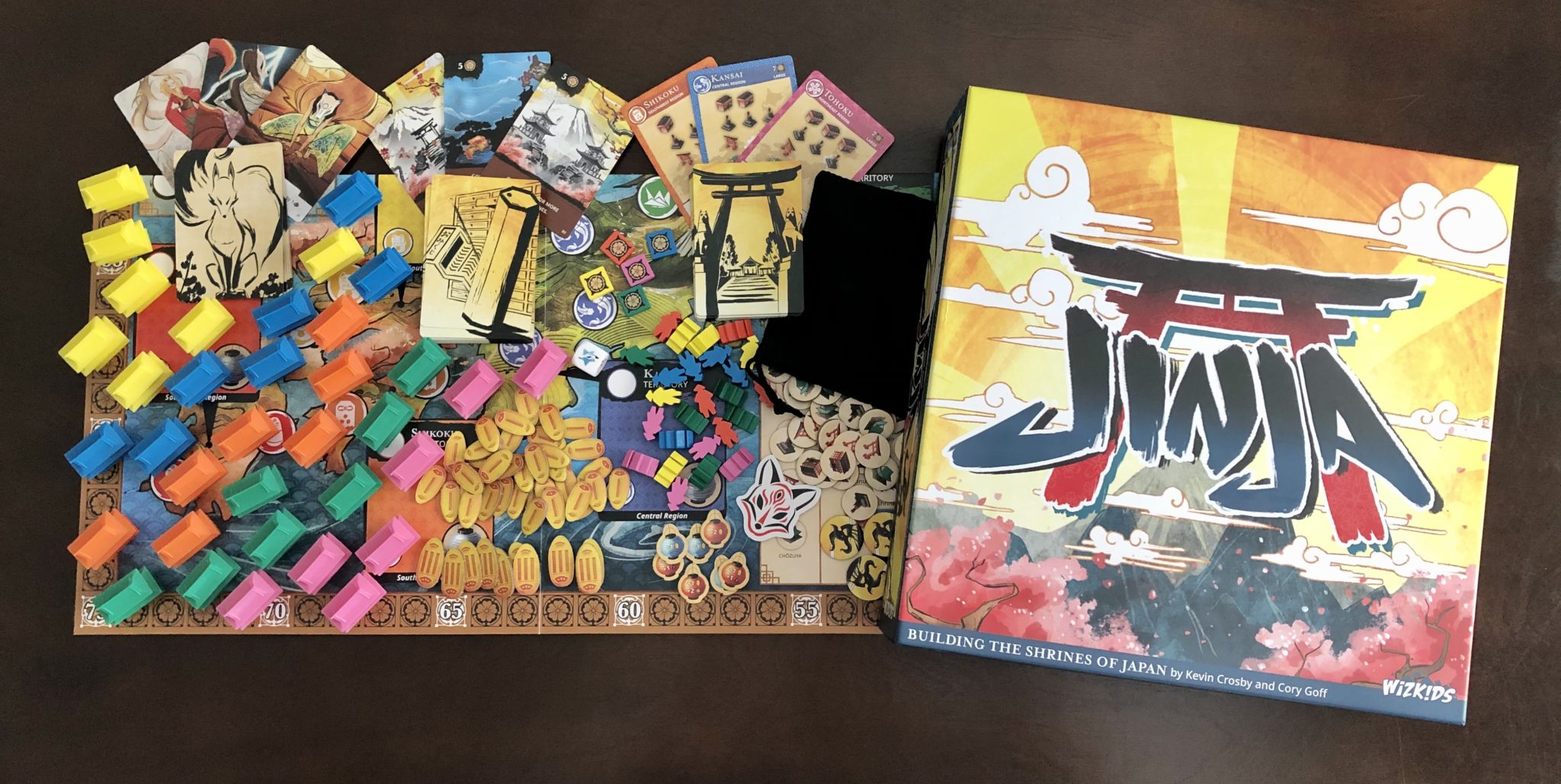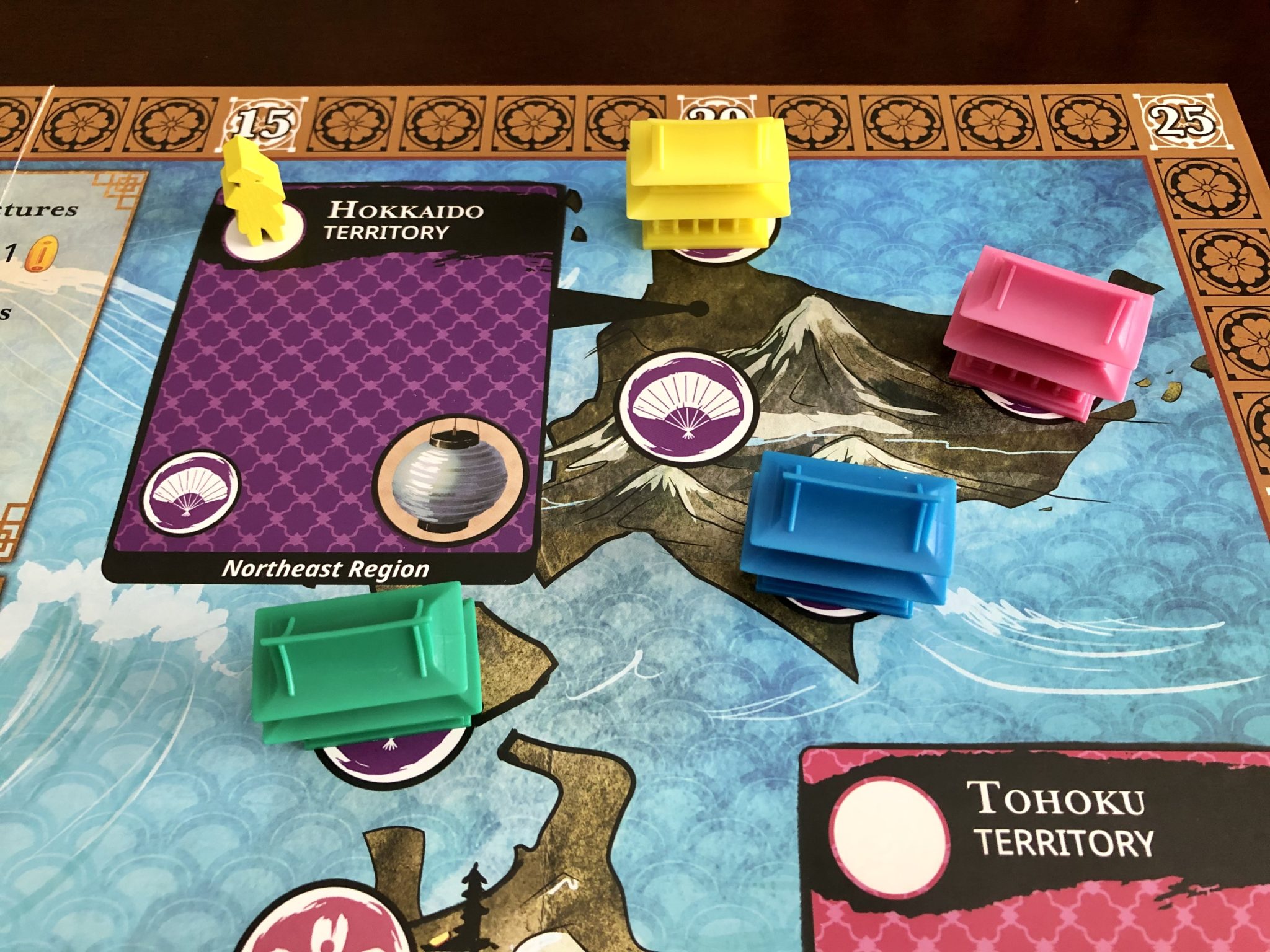Shinto shrines known as Jinja are a common sight in Japan, dedicated to housing divine spirits called Kami. The shrines vary in size depending on their importance. In Wizkids‘ newest game, Jinja, you’ll be doing the same. Will the kami be pleased by this offering, though? Well, WizKids sent a copy to us to find out!

What’s In The Box?
- 1 Board
- 1 Draw String Bag
- 35 Shrines, 7 per color
- 25 Workers, 5 per color
- 5 Honor trackers, 1 per color
- 28 Deed Cards
- 13 Kitsune Cards
- 34 Omikuji Cards
- 1 Mask die
- 20 Honden tokens
- 20 Kitsune Statue tokens
- 20 Torii Gate tokens
- 20 Chozuya tokens
- 36 1 gold tokens
- 10 3 gold tokens
- 5 Fox tokens
- 7 Lantern tokens
- 1 first player marker

How Does It Play?
Jinja is a worker placement game, with lots of resources to manage, with a goal to build shrines throughout Japan. Players will be placing one of their workers on the board to take its listed action which will be either exchanging resources in one way or another, get new cards for a price, paying to gain straight up points, or the heart of the game, building shrines.
Players start the game with a certain number of workers depending on the player count in the game, 2 gold, 2 random structures, and some players will receive a fox token. The main resource in the game is structures and are needed to build shrines. When a player has the structure tokens listed on one of their deed cards, they can spend them to build a shrine on that location shown on that deed card. Gold can be used to take several actions on the game board. And fox tokens are used to place a worked on an activity already occupied by an opponent’s worker.

To setup Jinja, players are dealt out 5 Omikuji cards which are essentially goal cards that award the stated points if you complete the listed objective. Players choose 3 to keep and can take actions to gain more during the game. Players are also dealt out 6 deed cards which are drafted by all players. Each player will take one card and pass the remaining repeating this until each player has 6 drafted deed cards. Deed cards are needed for players to build shrines in certain regions of the board, paying the listed structures on the card and then gaining the end of round bonus when the shrine is built.
Jinja plays over 5 seasons/rounds. A new random structure is drawn from the bag randomly and placed on each territory. This increases possible structures that players can collect. At the beginning of each season a Kitsune card is revealed. These cards will affect all players in some way or another and be active for that season. These cards have the best art in the game as well so it causes a nice pause between rounds.

Players will then perform the worker placement phase placing their worker meeple out on the board. All of the actions on the top left of the board are clarified in the rulebook. Players are mostly wanting to collect more and more structures to build the most shrines. Some actions let players gain structures with no further actions needed, usually gaining 1 or 2, but those actions are few and far between. Others might require players to use their gold to covert to structures. In addition to the actions listed on the top left, players can visit each territory on the map to either take the resources left on it, which can be a great action if left from season to season, or a player can visit a territory to build a shrine.
When building a shrine, the player will place a shrine figurine in the region matching the shrine card, and then will discard the required structure tokens back into the bag. That deed card is placed face up in front of that player and will give that player an added end of round bonus. Shrines will also give players added resources depending on the bonus listed on the lantern token on that territory. Shrines should be built to fulfill as many Omikuji cards as possible to gain extra points at the end of the game.

Other actions might cause a player to roll the die to gain a listed number of structures, points, or gold. There are plenty of actions to take in the game, but it can be difficult to find the best action that will convert your current resources into what you need to build what you want. Player should keep in mind that the game is 5 rounds and if they continually take actions to deplete their cards or resources, they might be placing themselves in a sticky situation on the last round.
After all players have placed their workers, the season ends. The current Kitsune card is flipped over. Players take back all their workers on the board. For every shrine a player has on the board, they get to take the lantern bonus associated with its territory. Each player will activate their end of season bonuses listed on their fulfilled deed cards. And lastly, the first player token is passed left to the next player. After 5 seasons the game end.
End of game scoring will occur. Each set of 5 resources, be it gold or structures is worth 2 points. Each unused fox token is worth 3 points. Fulfilled deed cards will earn points listed depending on the shrine’s size. Omikuji cards are scored if the requirements are fulfilled by that player. Lastly, each of the 3 regions will score 8 points for the player with the most shrines located in it.
The player will the most points wins the game!
The Verdict?
Jinja has a great look including some bright colors and cool plastic shrines. In fact, its one of the more beautiful games I’ve seen in a while. But sadly, looks isn’t everything. The game isn’t a bad game, but it’s a game where you have to spend a lot of actions to finally get certain structure tokens to build a shrine. The game almost teases players as it causes certain actions to be straight forward to get more structures, but other actions you will need to covert other resources to then gain other things that will lets you gain additional structures to complete their deed cards to build shrines.
The game tries to add additional complexity to the game by structuring a draft of deed cards before the game begins, and by causing players to analyze which actions are the most efficient for them to get their shrines built. There are ways to help players who didn’t draft their deed well, or ways that players can gain additional end game scoring goals when they weren’t dealt out a good variety that fits their deed cards. So, the game does a good job using modern mechanics, but they just seem forced together. What I mean is that these mechanics work, and they make the game better, but they just don’t cause the game to flow as smoothly as it should.

My biggest concern about the game is the rulebook. While first flipping through it, I thought it was great, straight to the point and not super lengthy. But as I started to read and learn how to play the game, the questions I had weren’t answered anywhere in the book. In fact, I thought maybe there was an additional supplement sheet that listed out all the Kitsune card actions, or a better explanation where I can place my worker out on the board. These were eventually answered while we actually played the game as any other way wouldn’t make much sense.
What Jinja does well is the area majority system. It works to give additional bonuses or actions as well as gives a main focus to the game. Players should plan their strategy around their Omikuji cards. This will give players a goal as to where they need to build their shrines. When drafting deed cards, they should then understand which ones will fit their chosen Omikuji cards and maybe which ones that don’t that can be sacrificed for a powerful action. After making a game plan, the player will just need to choose smart actions with their workers to get them to the finish line of that strategy. Understanding the conversion of resources with all the available actions is a big part of this.
[rwp_box id=”0″]
Jinja can be pre-ordered from Wizkids or at your FLGS, where it’ll run you about $49.90
Images via Wizkids
Have strong thoughts about this piece you need to share? Or maybe there’s something else on your mind you’re wanting to talk about with fellow Fandomentals? Head on over to our Community server to join in the conversation!

